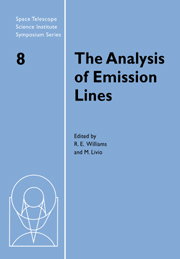Book contents
- Frontmatter
- Contents
- Participants
- Preface
- Emission Lines: Past and Future
- Atomic Data for the Analysis of Emission Lines
- Radiative Transfer
- Emission Lines from Winds
- Photoionizing Shocks
- The Lexington Benchmarks for Numerical Simulations of Nebulae
- Emission Line Diagnostics
- Ultraviolet Spectroscopy
- Infrared Emission Lines as Probes of Gaseous Nebulae
- Molecular Emission Line Diagnostics in Astrophysical Environments
- Abundance Determinations
- Astrophysical Gamma Ray Emission Lines
- Summary Remarks
Emission Lines: Past and Future
Published online by Cambridge University Press: 23 November 2009
- Frontmatter
- Contents
- Participants
- Preface
- Emission Lines: Past and Future
- Atomic Data for the Analysis of Emission Lines
- Radiative Transfer
- Emission Lines from Winds
- Photoionizing Shocks
- The Lexington Benchmarks for Numerical Simulations of Nebulae
- Emission Line Diagnostics
- Ultraviolet Spectroscopy
- Infrared Emission Lines as Probes of Gaseous Nebulae
- Molecular Emission Line Diagnostics in Astrophysical Environments
- Abundance Determinations
- Astrophysical Gamma Ray Emission Lines
- Summary Remarks
Summary
In the first half of this century many emission lines were or had been identified. Noteworthy moments were the identification of the Nebulium lines (λ 4959/5007) as forbidden lines of O++ (Bowen 1927) and of the strong solar green coronal line λ 5303 as due to Fe13+ (Edlen 1942). In addition, a first quantitative understanding of some aspects of nebular spectra was obtained: the Balmer decrement was calculated by Menzel and associates (1937), the temperatures of the central stars of planetary nebulae were inferred by Zanstra (1927), and the first information on elemental abundances in nebulae was gained.
In the second half of this century a much more detailed understanding of emission spectra was acquired. Emission lines assumed a fundamental role for the diagnostics of conditions in nebulae. As a result electron densities Ne and temperatures Te as well as elemental abundances became known in many objects. Excitation and ionization conditions in nebulae were found to be frequently radiative (photoionization), but shocks and perhaps fast particles were also found to play a role. Non-equilibrium conditions were seen to be important especially in the hot, tenuous plasmas revealed by X-ray observations: the ionization state was often different from that expected from the temperature, and even Te and the temperature of the proton gas could be different.
Chemistry was found to play a role in many emission nebulae. Numerous new molecules were observed, especially by radio observations in cool, dense media.
- Type
- Chapter
- Information
- The Analysis of Emission Lines , pp. 1 - 7Publisher: Cambridge University PressPrint publication year: 1995



